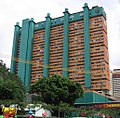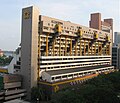林少偉(英語:William Lim Siew Wai,1932年7月19日—2023年1月7日[1]),新加坡建築師、新加坡傳統文化學會創辦人,曾參與設計珍珠坊、黃金坊、新加坡大會堂等多個新加坡著名地標建築[2]。
教育
事業
從1957年起,他作為合夥人在新加坡和馬來西亞的幾家公司工作。他的工作從為住宅和商業利益設計現代主義建築開始,然後發展到新加坡和吉隆坡的大型購物中心。林少偉的設計作品包括後來成為新加坡商業發展的典範的珍珠坊(1973年);黃金坊(1974年);和東陵購物中心。
1981年[3],他開始創業,他也是新加坡傳統文化學會的創始成員[4],在1987年到1997年之間,擔任學會的第一次任會長[2]。林少偉還曾任Asian Urban Lab的聯合創始人兼主席,以及Architectural Association of Asia(AA Asia)的主席。他在2002年退休[2]。林少偉於2002年被澳大利亞墨爾本皇家理工大學授予榮譽建築學博士學位,並於2005年被任命為拉薩爾 - 新航藝術學院 英語:LaSalle-SIA College of the Arts)名譽教授。他亦曾任中國天津大學的客座教授。
林少偉撰寫和演講的主題廣泛,涉及亞洲的建築、城市化和文化,以及與後現代、全球在地化和社會正義相關的當前課題[5]。他是 Asian Alterity: With Special Reference to Architecture and Urbanism through The Lens of Cultural Studies (2008) 的作者,以及 Asian Design Culture (2009) 的編輯和 Non West Modernist Past (2011) 的聯合編輯。
個人生活
作品
- 1973 珍珠坊
- 1974 黃金坊
- 1980 東陵購物中心
- 1987 新加坡救主堂
- 1999 馬林百列社區綜合大廈
- 2000 佳樂麗酒店
-
新加坡珍珠坊
-
新加坡黃金坊
-
新加坡馬林百列社區綜合大廈
書籍
- 1990 Cities for People: Reflections of a Southeast Asian Architect, Select Books
- 1998 with Tan Hock Beng: Contemporary Vernacular: Evoking Traditions In Asian Architecture, Select Books
- 1998 Asian new urbanism and other papers, Select Books
- 2005 Asian Ethical Urbanism: A Radical Postmodern Perspective, 世界科學出版社
- 2008 Asian Alterity: With Special Reference to Architecture and Urbanism Through the Lens of Cultural Studies, 世界科學出版社
- 2012 Incomplete Urbanism: A Critical Urban Strategy for Emerging Economies, 世界科學出版社
參考文獻
Wikiwand in your browser!
Seamless Wikipedia browsing. On steroids.
Every time you click a link to Wikipedia, Wiktionary or Wikiquote in your browser's search results, it will show the modern Wikiwand interface.
Wikiwand extension is a five stars, simple, with minimum permission required to keep your browsing private, safe and transparent.




